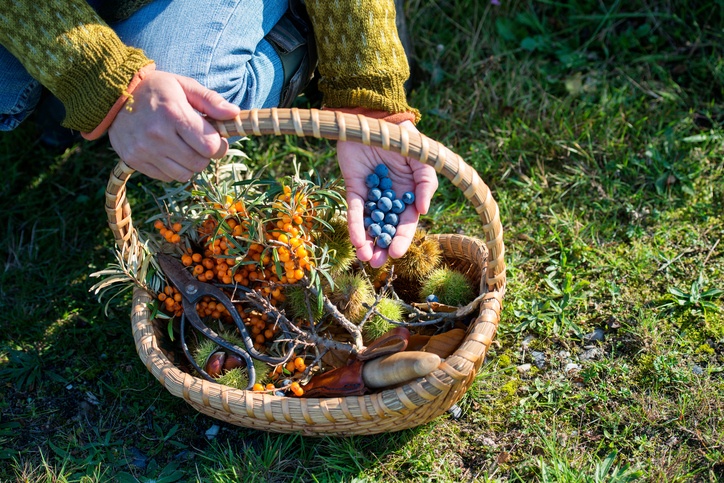
Foraging for edible herbs, as our ancestors did, is not just an interesting activity. It provides you with free food, nutritious and untainted by artificial methods of cultivation. Although it is nearly impossible to find any place on earth completely free of pollutants, wild plants are still better off than commercially cultivated crops. Moreover, you get a wide variety of plant nutrients that are generally lacking in our staple diet.
Here are some of the edible herbs you can look for in and around your property:
1. Dandelion – Taraxacum officinale
This all-pervasive weed doesn’t need any introduction, it’s nearly impossible to miss the familiar golden blooms anywhere. However, the ones growing in your lawn or backyard may not be fit for consumption if you’ve been unleashing chemical warfare on them, however unsuccessfully. The flowers, leaves and the root are all edible. Sauté the leaves or cook it like spinach, add it fresh to salads and sandwiches. You can batter-fry the flowers or make jelly or tea with them.
Rich in beta-carotene, Vitamin C, calcium, and potassium, Dandelion is a good antioxidant and mineral source. As an excellent diuretic and mild laxative, it helps clean out the liver, kidneys, and the urinary bladder.
2. Purslane – Portulaca oleracea
Purslane is a ground hugging herb that is easily missed, unless you’re looking for it, but then you notice it growing almost everywhere, especially in exposed areas where nothing much grows. The tiny succulent leaves, yellow flowers and the pink, fleshy stems are all edible. They have a nice bite and a slight sour taste that will invite you to nibble on them as you gather them.
Purslane has a history of being used as a culinary herb. You can eat it raw or cooked. The mucilaginous stems help thicken gravies and soups. Purslane contains Vitamin A, C and E and a number of minerals. It is an excellent vegetable source of Omega–3 fatty acids.
3. Violets – Viola spp.
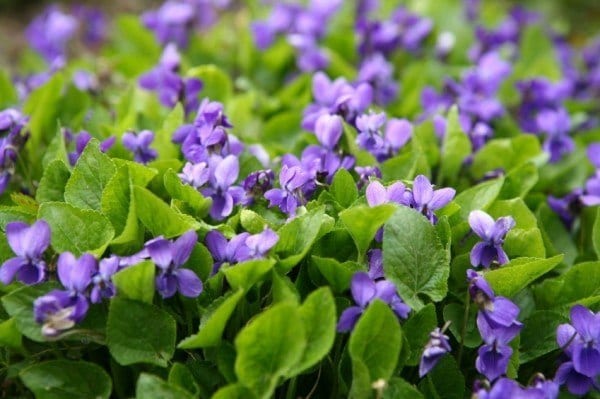
You can find violets with their small, heart-shaped leaves and pretty, blue flowers growing in shady areas. It is best to identify them by their flowers rather than leaves because a few other plants, including a type of poisonous lily of the valley, have similar-looking leaves.
You can add violet leaves and flowers to salads. The wild violets may not carry the characteristic fragrance of garden violets, but they are just as edible and tasty. Crystallized violets make excellent decorations for cakes and desserts. Violet honey and tea can soothe a sore throat and headache and reduce inflammation–not surprising since the flowers contain salicylic acid.
4. Lemon balm – Melissa officinalis
Among the many mint-family herbs you will come across in the wild, lemon balm is easily recognizable by its lemony fragrance when you crush the leaves. You can eat them raw or cooked. A tea made of lemon balm leaves is soothing and relaxing. It is a traditional herbal remedy for digestive problems, even in small children and the elderly.
You can make lemon flavored vinegar and herb butter with lemon balm or just chop up the leaves and add to salads and meat dishes. Dry the surplus leaves in the shade and store in airtight jars. Lemon balm is known to have a negative effect on thyroid function, so it should be used with caution.
5. Garden cress – Lepidium sativum
Garden cress is commonly found in gardens and backyard. Although it is considered a weed in most places, it is commercially cultivated in many European countries, including England. The spicy, peppery taste of garden cress makes it popular in salads and sandwiches.
Garden cress is rich in carotenoids and vitamin C. In laboratory studies, it is shown to have anticancer properties similar to those exhibited by other plants of the cabbage family. Garden cress contains high amounts of vitamin K too.
6. Watercress – Nasturtium officinale
This relative of garden cress has a wide distribution throughout the world. As the name indicates, it is an aquatic/semi aquatic plant that you will probably see growing near the ponds and lakes in your neighborhood. And wherever it grows, it grows in abundance, so there’s little danger of the wild stock running out. As a matter of fact, watercress is grown on commercial scale in many parts of the world.
Watercress contains appreciable amounts of vitamins A, C and a few of the B-complex group of vitamins, including folate. You can add raw watercress leaves to salads or sauté or stir fry them like other greens. Wash them thoroughly to remove dirt and other contaminants that find their way into water bodies.
7. Lamb’s Quarters – Chenopodium alba
Lamb’s quarters is a close relative of quinoa, and has a history of being cultivated for its seeds. Known by common names such as white goosefoot and pigweed, you can find it growing as a weed in cultivated gardens or in wild patches. The young leaves are fuzzy, and sometimes tinged with pink. They can be eaten raw along with the tender stems, but preferably eaten cooked like spinach.
Lamb’s quarters is nutritious, rich in vitamins and minerals, especially Vitamins A, K and C. In traditional Indian herbal medicine, it is used as a laxative and a remedy against roundworms and hookworms. A paste of the leaves is applied to burns and sun burnt skin for its cooling and healing effect.
8. Wild leek – Allium tricoccum/A. ampeloprasum
Wild leeks, commonly called ramps, or ramsons, are a typical example of how anyone can make a tasty meal out of wild plants. If you live in and around the Appalachians, you can probably find several patches of wild leeks in any woodland near you. These large-leaved onion relatives are easy to spot, especially since they are one of the earliest plants to wake up in spring. The whole plant is edible, but if their looks fail to convince you, their unmistakable garlicky smell will. It’s a good idea to do a smell test anyway because you shouldn’t be picking the poisonous lily of the valley which has similar leaves.
You can cook ramps in a variety of ways; sauté them, batter fry them, add them to soups and casseroles or pickle them. They are so versatile that the ramp-eating festivals, like the famous Richwood Ramp Fest that takes place every year in April in West Virginia.
9. Wild garlic – Allium ursinum
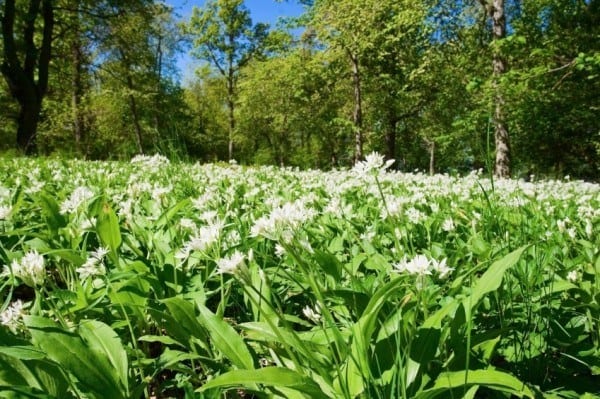
Wild garlic, is another onion family member that you might come across as you forage for edibles. Widely distributed in USDA Zone 4-9, it is considered an invasive plant in many areas, so you will be doing a favor by digging some up. However, they don’t have much of a bulb. The broad leaves and the tender flower buds on long stalks are what you should be after; they are aplenty in April-June.
You can cook the leaves like spinach or make a pesto with it. Add the flower buds to soups, salads, and omelet. The leaves tend to be bitter once the white flower clusters open, but they are edible still. Check for the garlicky smell to ensure you have the right plant.
10. Daylilies – Hemerocallis fulva
The tawny daylily is often seen growing in moist soil along ditches, roads and railway lines, hence it has earned several names such as ditch lily and railroad lily. The large, showy flowers and their buds can be cooked and eaten like any vegetable. The dried flower buds used in Chinese cooking are called golden needles. The thick, fleshy roots can be boiled and eaten, but it has a very mild, watery taste.
11. Wild asparagus – Asparagus officinalis
The shooting spears of wild asparagus are hard to spot in wild thickets unless you know where to look for them. The dead stems of the previous year can indicate their presence among shrubby vegetation in exposed areas. Look closely, and you may see the new growth emerging, but the spears are much thinner than those of the garden asparagus. Once you mark the spot and pick the spears judiciously, the same patch can serve you year after year.
Cook the wild asparagus spears as would cook the cultivated ones. Asparagus has a diuretic effect which helps relieve urinary tract infections. It is considered a detoxifier and cleanser, beneficial in relieving constipation and rheumatic pain.
12. Plantain – Plantago major
The large leaves of plantain ensure that you don’t miss this edible plant. If it grows all over your property and you consider it a weed, take sweet revenge by eating them. The leaves are tough, but you can soften them by blanching in boiling water and then sautéing.
Historically, plantain has been used to treat gastrointestinal and respiratory problems. It is particularly good for relieving dry cough.
13. Yellow rocket – Barbarea vulgaris
This mustard family member is an American native with a wide distribution across the country. Easily identified by the bright yellow bunch of flowers that shoots up from a rosette of basal leaves in early spring, yellow rocket makes an excellent salad green. They can be cooked like a vegetable, but are best when tender.
Yellow rocket can be distinguished from other mustard family plants like black mustard and wild mustard by its smooth, non-hairy leaves. It is also called winter cress because it is one of the first salad green to emerge. The plant is rich in vitamin C and minerals. A poultice of the leaves is an herbal remedy for wounds.
14. Garlic mustard – Alliaria petiolata
Garlic mustard is a cabbage family member that is completely edible. The characteristic garlic smell helps identify this plant, especially when this biannual remains just a tuft of leaves in the first year. A long stalk carrying white flowers arises in the second year. Add these flowers to salads. Cook the leaves like a vegetable, although they may become rather bitter when mature. You can dig up the root and eat it too.
Garlic mustard has antimicrobial properties which help heal wounds. It is a good diuretic too.
15. Wild strawberry – Fragaria vesca
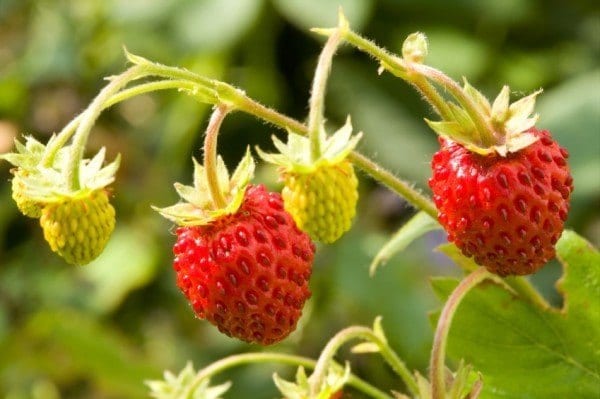
Wild strawberries are much smaller than the cultivated varieties, but they are so dainty and flavorful, it is a pleasure to gather them in summer. If you manage to pick enough from these ground hugging plants, you can make jams and jellies out of them, but they usually get eaten fresh. They help you get rid of the tartar on your teeth.
The leaves have medicinal properties. They are said to flush out uric acid from the body, making them useful to people with gout.
16. Wood sorrel – Oxalis acetosella
This is another lowly plant that grows no more than a few inches. The stem is an underground rhizome that creeps along the ground just below the surface, sending up tufts of long-stemmed leaves at intervals. The leaves are trifoliate, with a central fold on each leaflet along which they fold at night. They taste sour when chewed, and are good for grinding into a tangy dip, although its oxalic acid content is a concern.
Wood sorrel is an herbal remedy for mouth ulcers, and a good source of Vitamin C. The starchy rhizomes are edible when boiled.
17. Mallow – Malva sylvestris
Mallow is a perennial herb from the hibiscus family, and carries small flowers that are edible. In fact, all parts of the plant are edible, including the root. The leaves are used in salads or added to soups where their mucilage helps thicken them. The immature seed pods can be used like the vegetable okra, although they are much smaller in size. You can stir fry them for a tasty side dish.
Mallow’s medicinal properties have been put to good use in herbal remedies for respiratory and gastrointestinal problems. The mucilage soothes their lining and helps relieve cough and constipation.
18. Fiddleheads – Matteuccia struthiopteris
Almost all ferns have fiddleheads, which are nothing but the immature fronds that remain in a tight coil. Many types of fiddleheads are edible, but it is the ostrich fern fiddleheads that you should look out for. You can spot them in early spring when they are covered in characteristic brown or bronze scales.
While gathering fiddleheads from the wild, you should exercise restraint, taking away only a few of them from each cluster. You can cook them as you would cook asparagus.
19. Cattails – Typha latifolia
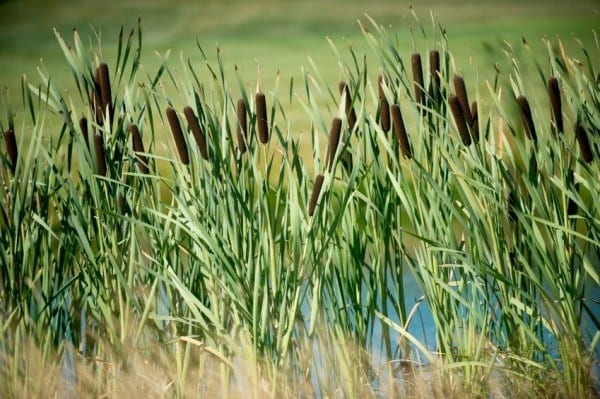
You can easily spot cattails growing in wetlands by their thick, brown, sausage-shaped inflorescence held above the foliage on long stalks. These can be boiled and eaten when immature. The starchy rhizome is another nutritious part of the plant that can serve as a sustenance food in difficult times.
Native American people extracted starch from the rhizome and made it into flour for making bread. The young shoots and the white portion at the base of the leaves and flower stalks can be eaten raw or cooked.
20. Prickly pear cactus – Opuntia spp.
In arid regions, prickly pear cactus could be your best bet when it comes to survival food. The cactus pads are not only tasty and nutritious but full of water that would help you rehydrate. It is called nopales in Mexico.
The main problem with the pads is the glochids that form tiny tufts at the base of the spines. You should meticulously remove them by rubbing them on a stone or scraping with a knife under running water. The ovoid fruits which give this cactus its common name are also edible and delicious, but should be cleaned well.
21. Milk thistle – Silybum marianum
It is surprising how this spiny plant can provide both food and medicine. The edible roots can be accessed after cutting down the plant, but gathering the other edible parts can be quite a problem. You can eat the starchy root raw or cooked like a tuber. If you have the patience to remove the spines from the stems and leaves, they can be cooked like vegetables too.
The plant is valued for its detoxifying effect on the body, particularly liver. It is part of many Chinese herbal preparations.
Caution: Gather only plants that you are familiar with. Carry along a handbook of edible herbs with clear pictures and descriptions to help identify them – such as Edible Wild Plants – A North American Field Guide To Over 200 Natural Foods. Avoid eating foraged herbs during pregnancy, while nursing or if you are on any medication.
